Practice Test 3 - AP English Language and Composition
Section I
TIME: 1 HOUR
DIRECTIONS: Questions 1–13. Carefully read the following passage and answer the accompanying questions.
The passage is an excerpt from an essay by a 19th-century American author.
Passage 1
But it is mostly my own dreams I talk of, and that will somewhat excuse me for talking of dreams at all. Everyone knows how delightful the dreams are that one dreams one’s self, and how insipid the dreams of others are. I had an illustration of the fact, not many evenings ago, when a company of us got telling dreams. I had by far the best dreams of any; to be quite (5)frank, mine were the only dreams worth listening to; they were richly imaginative, delicately fantastic, exquisitely whimsical, and humorous in the last degree; and I wondered that when the rest could have listened to them they were always eager to cut in with some silly, senseless, tasteless thing that made me sorry and ashamed for them. I shall not be going too far if I say that it was on their part the grossest betrayal of vanity that I ever witnessed.
(10)But the egotism of some people concerning their dreams is almost incredible. They will come down to breakfast and bore everybody with a recital of the nonsense that has passed through their brains in sleep, as if they were not bad enough when they were awake; they will not spare the slightest detail; and if, by the mercy of Heaven, they have forgotten something, they will be sure to recollect it, and go back and give it all over again with added (15)circumstance. Such people do not reflect that there is something so purely and intensely personal in dreams that they can rarely interest anyone but the dreamer, and that to the dearest friend, the closest relation or connection, they can seldom be otherwise than tedious and impertinent. The habit husbands and wives have of making each other listen to their dreams is especially cruel. They have each other quite helpless, and for this reason (20)they should all the more carefully guard themselves from abusing their advantage. Parents should not afflict their offspring with the rehearsal of their mental maunderings in sleep, and children should learn that one of the first duties a child owes its parents is to spare them the anguish of hearing what it has dreamed about overnight. A like forbearance in regard to the community at large should be taught in the first trait of good manners in public schools, (25)if we ever come to teach good manners there.
Certain exceptional dreams, however, are so imperatively significant, so vitally important, that it would be wrong to withhold them from the knowledge of those who happened not to dream them, and I could scarcely forgive myself if I did not, however briefly, impart them. It was only last week, for instance, that I found myself one night in the company of (30)the Duke of Wellington, the great Duke, the Iron one, in fact; and after a few moments of agreeable conversation on topics of interest among gentlemen, his Grace said that now, if I pleased, he would like a couple of those towels. We had not been speaking of towels, that I remember, but it seemed the most natural thing in the world that he should mention them in the connection, whatever it was, and I went at once to get them for him. At the place (35)where they gave out towels, and where I found some very civil people, they told me that what I wanted was not towels, and they gave me instead two bath-gowns, of rather scanty measure, butternut in color, and Turkish in texture. The garments made somehow a very strong impression upon me, so that I could draw them now, if I could draw anything, as they looked when they were held up to me. At the same moment, for no reason that I can allege, I (40)passed from a social to a menial relation to the Duke, and foresaw that when I went back to him with those bath-gowns he would not thank me as one gentleman to another, but would offer me a tip as if I were a servant. . . .
This seemed to end the whole affair, and I passed on to other visions, which I cannot recall.
1. Which of the following best describes the writer’s exigence in the passage?
(A) Increasing resentment and antagonism between social classes
(B) The innate shortsightedness of upper-class people
(C) The unwillingness of some people to cast off their own misperceptions
(D) The insensitive ways in which people often treat one another
(E) How personal ambition can destroy compatibility between friends
2. In lines 2–3 (“Everyone knows . . . dreams of others are”), the speaker’s rhetorical intent is primarily to
(A) please the members of audience by confiding in them.
(B) impress the audience with the depth of his understanding of the subject.
(C) utter a controversial truth for the audience to ponder.
(D) demonstrate that he has given the matter of dreams a great deal of thought.
(E) engage the audience by stating a view with which they are likely to agree.
3. In context, lines 4–10 (“I had by far . . . almost incredible”) could be used to support all of the following claims about the speaker’s tone EXCEPT
(A) He adopts a reverent tone when describing the nature of his own dreams.
(B) His tone is reproachful when describing others who like to talk about their dreams.
(C) When describing the qualities of his own dreams he uses a self-serving tone.
(D) When describing his own dreams, the speaker assesses them realistically.
(E) His tone when describing the content of other people’s dreams is derisive.
4. In context, the rhetorical intent of the sentence in line 10 (“But the egotism . . . incredible”) is primarily to
(A) attract the attention of those who enjoy analyzing their own and others’ dreams.
(B) prepare the audience for an illustrative anecdote about “incredible” egotism.
(C) reinforce the depth of the speaker’s alienation from reality.
(D) reveal the speaker’s insights into human behavior.
(E) suggest that dream interpretation is an inexact science.
5. Which of the following best describes the rhetorical function of the sentence (lines 10–15) in the second paragraph?
(A) It provides details to support the preceding generalization.
(B) It reiterates the main idea of the passage.
(C) It presents an alternative view of the passage’s main subject.
(D) It undercuts an assertion made in the first paragraph.
(E) It introduces a question to be answered later in the passage.
6. All of the following excerpts from the passage contribute to the speaker’s emotive intent EXCEPT
(A) “how insipid the dreams of others are” (line 3).
(B) “silly, senseless, tasteless thing” (lines 7–8).
(C) “grossest betrayal of vanity” (line 9).
(D) “will not spare the slightest detail” (line 13).
(E) “tedious and impertinent” (line 18).
7. In the second paragraph (lines 10–25), the speaker sketches out the behavior of “some people” mainly to
(A) make the point that dreamers are subject to excessive vanity.
(B) argue that dreams can be a source of conflict and anguish in human relationships.
(C) stress that accurate accounts of dreams are unusually rare.
(D) illustrate that dreams encourage erratic and ludicrous behavior.
(E) advise the audience to be discreet when recounting their dreams to others.
8. The last sentence of the second paragraph (lines 23–25) can best be described as
(A) a generalization followed by a specific example.
(B) a suggestion followed by a reason for it.
(C) a statement about a cause and its effect.
(D) a reasonable assumption and logical conclusion.
(E) a recommendation followed by an editorial comment.
9. At the start of the third paragraph (line 26) the writer uses “however,” in order to
(A) contradict an idea stated earlier about teaching children good manners in school.
(B) introduce an alternative point of view about recitations about one’s dreams.
(C) assert that a skill can be acquired to assure that listeners will be rapt when hearing about a dream.
(D) remind the audience that not all dreams, as stated in lines 7–8, are “silly,” “senseless,” and “tasteless.”
(E) reassure the audience that he still has a great deal of importance to say.
10. That the speaker declares that some dreams “are so imperatively significant, so vitally important” (lines 26–27) is ironic mainly because
(A) the speaker has been railing against the telling of dreams.
(B) some dreams are “exceptional” (line 26).
(C) the speaker has characterized dreams as “intensely personal” (lines 15–16).
(D) irrational events occur in dreams as well as in reality.
(E) people rarely remember their dreams.
11. In the context of the passage, all of the following phrases refer to the same idea EXCEPT
(A) “first duties a child owes to its parents” (line 22).
(B) “ . . . if we ever come to teach good manners” (line 25).
(C) “agreeable conversation on topics of interest among gentlemen” (line 31).
(D) “civil people” (line 35).
(E) “thank me as one gentleman to another” (line 41).
12. The speaker’s report of his nighttime encounter with the Duke of Wellington (lines 29–42) contributes to the overall unity of the passage in which one of the following ways?
(A) As proof of the fleeting nature of dreams
(B) As a deliberate example of a “silly, senseless, tasteless thing” (lines 7–8)
(C) As a description of the speaker’s social status
(D) As evidence that dreams leave permanent impressions on the dreamer
(E) As an illustration of the speaker’s conviction that accounts of his own dreams are “worth listening to” (line 5)
13. The use of an ellipsis at the end of line 42 is meant to suggest that the speaker
(A) thinks it’s been a mistake to recount this particular dream.
(B) suddenly discovered that he’s humiliated himself.
(C) has experienced a failure of memory.
(D) has been rendered speechless by a strong emotional reaction.
(E) regrets that he misrepresented the truth.
DIRECTIONS: Questions 14–23. Carefully read the following passage and answer the accompanying questions.
The passage below is part of a talk delivered by T. S. Eliot, a renowned 20th-century poet.
Passage 2
I hold no diploma, certificate, or other academic document to show that I am qualified to discuss this subject. I have never taught anybody of any age how to enjoy, understand, appreciate poetry, or how to speak it. I have known a great many poets, and innumerable people who wanted to be told that they were poets. I have done some teaching, (5)but I have never “taught poetry.” My excuse for taking up this subject is of wholly different origin. I know that not only young people in colleges and universities, but secondary school children also, have to study, or at least acquaint themselves with, poems by living poets; and I know that my poems are among those studied. This fact brings some welcome supplement to my income; and it also brings an increase in my correspondence, (10)which is more or less welcome, though not all the letters get answered. These are the letters from children themselves, or more precisely, the teenagers. They live mostly in Britain, the United States, and Germany, with a sprinkling from the nations of Asia. It is in a spirit of curiosity, therefore, that I approach the subject of teaching poetry: I should like to know more about these young people and about their teachers and the methods (15)of teaching.
For some of my young correspondents seem to be misguided. Sometimes I have been assigned to them as a “project,” more often they have made the choice themselves—it is not always clear why. (There was one case, that of an Egyptian boy, who wanted to write a thesis about my work, and as none of my work was locally available and as he wanted to (20)read it, asked me to send him all my books. That was very exceptional, however.) Very often the writers ask for information about myself, sometimes in the form of a questionnaire. I remember being asked by one child whether it was true that I only cared to associate with lords and bishops. Sometimes a photograph is asked for. Some young persons seem to want me to provide them with all the material for a potted biography, including mention of my (25)interests, tastes, and ways of amusing myself. Are these children studying poetry, or merely studying poets? Very often they want explanations, either of a whole poem (“what does it mean”) or of a particular line or phrase; and the kind of question they ask often suggests that their approach to that poem has been wrong, for they want the wrong kind of explanation, or ask questions which are simply unanswerable. Sometimes, but more rarely, they are (30)avid for literary sources, which would seem to indicate that they have started too early on the road to Xanadu.
Now, when I was young, this sort of thing did not happen. I did study English at school, beginning, thank God, with grammar, and going on to “rhetoric”—for which also I am grateful. And we had to read a number of set books of prose and verse—mostly in school (35)editions which made them look peculiarly unappetizing. But we never were made to read any literature which could be called “contemporary.”
No. Not only were we not encouraged to take an interest in the poetry actually being written, but even had we been, I doubt whether we should have thought of entering into correspondence with the authors. Some of the juvenile correspondence I receive seems to (40)be instigated by the teachers, but the greater part does not. Indeed, some of my letters, I suspect, are inspired by a desire to score off the teacher in the hope of getting some statement from the horse’s mouth which will be a direct contradiction of what has been taught. (I confess that this last type of letter is one which I sometimes take pleasure in answering—when the teacher seems to have been wrong.) But my point is that this pressure upon the (45)poet from young people who have been compelled to read his work is a modern phenomenon. I don’t believe that Tennyson and Browning, Longfellow and Whittier (to say nothing of Poe and Whitman, poets whose works we did not study) were embarrassed by juvenile correspondence choking up their letter boxes. The teaching of the contemporary literature, the introduction of the young to poetry by living poets, is something that came about in my (50)time without my being aware of what was happening.
14. The speaker’s rhetorical purpose in the opening paragraph (lines 1–10) is primarily to
(A) win the audience’s sympathy.
(B) highlight the divisions between poetic theory and practice.
(C) raise doubts about his qualifications to talk about the topic.
(D) disabuse the audience of preconceptions about his expertise or his stature as a poet.
(E) introduce the audience to the subject he intends to talk about.
15. Which of the following best accounts for setting the phrase “taught poetry” in quotation marks (line 5)?
(A) The speaker means to ridicule the notion that poetry writing can be taught.
(B) The speaker believes that teaching poetry is a fanciful—or at least a questionable—enterprise.
(C) The quotation marks indicate that the speaker is being ironic.
(D) The punctuation suggests that the speaker has never been successful in teaching others how to write poems.
(E) The quoted phrase has become a cliché among teachers of poetry.
16. In the opening paragraph (lines 1–15), which of the following best characterizes the speaker’s justification for choosing the topic of his talk?
(A) His teaching experience—although limited—has been exceptionally gratifying.
(B) Students apparently have an interest in contemporary poets.
(C) He has been charmed by young people’s attention to his poetry.
(D) He is intrigued by the lives of youngsters who have written him letters.
(E) He is puzzled by the rationale behind the letters written to him by students.
17. In the context of the passage, all of the following excerpts contribute to the speaker’s main purpose EXCEPT
(A) “I have done some teaching . . .” (line 4).
(B) “welcome supplement to my income” (lines 8–9).
(C) “an increase in my correspondence” (line 9).
(D) “only cared to associate with lords and bishops” (lines 22–23).
(E) “my interests, tastes, and ways of amusing myself” (lines 24–25).
18. Based on lines 26–31, which of the following best characterizes the speaker’s position on the relevance of his topic for teachers of poetry?
(A) Because the standards for understanding poetry are relatively diffuse, teachers can enrich students’ comprehension by adding poets’ biographical information.
(B) By accepting the criticism he offers, teachers will help students explicate poems more thoroughly.
(C) By adopting the speaker’s viewpoint, teachers can alter the widespread belief that a poem has a specific meaning or message.
(D) After considering the speaker’s views, teachers should regularly ask students to justify or explain their interpretations of poems.
(E) Acknowledging that the speaker’s opinions are valid, a poetry teacher ought to encourage students to write poems of their own.
19. In the second paragraph (lines 16–31), the speaker describes communications he has received from students primarily to
(A) illustrate the shortcomings of being an acclaimed poet.
(B) record dismay over what constitutes the study of poetry in schools.
(C) commend young people for the depth of their knowledge and appreciation of poetry.
(D) question the decision of teachers to concentrate on the works of living poets.
(E) express concern that teaching poetry in schools is often counterproductive.
20. Which of the following best characterizes the rhetorical function of the first sentence of the third paragraph (line 32)?
(A) It provides a logical transition between the third and fourth paragraphs.
(B) It restates the main idea of the previous paragraph.
(C) It bolsters the main point of the third paragraph.
(D) It introduces a change in the speaker’s attitude toward the topic of the passage.
(E) It briefly summarizes the main idea of the passage.
21. In context, all of the following describe the speaker’s rhetorical intent in using the expression “thank God” (line 33) EXCEPT
(A) to indicate that he is a devout, God-fearing individual.
(B) to suggest that writing letters to poets is less valuable than studying grammar.
(C) to express skepticism about the usefulness of some current educational practices.
(D) to imply that knowledge of grammar is essential to a good education.
(E) to encourage his audience to master English grammar.
22. In context, lines 37–50 (“No. Not only . . . what was happening”) could be used to support which of the following claims about the speaker’s tone?
(A) His tone when discussing poetry being written at the time is sentimental.
(B) He adopts a mischievous tone when discussing reasons why some students wrote letters to him.
(C) He adopts a critical tone in describing the pressure often placed upon modern-day poets.
(D) He uses a skeptical tone when musing on the experience of poets of the past.
(E) His tone is disgruntled when acknowledging that he’d been unaware that students had been learning about contemporary poets.
23. Based on the diction in lines 46–48 (“I don’t . . . letter boxes”), which of the following best characterizes the speaker’s feelings about his role as a contemporary poet?
(A) Pressure to make a living as a poet
(B) Satisfaction about his success
(C) Envy of Tennyson, Browning, and other poets of old
(D) Regret over time spent responding to young people’s letters
(E) A mix of embarrassment and delight over being singled out as a source of wisdom
DIRECTIONS: Questions 24–31. Carefully read the following passage and answer the accompanying questions.
The passage below has been adapted from a psychological research report, dated 2019. It is a draft.
Passage 3
(1) Humans are secretive creatures with brains adept at concealing information. (2) Yet surprisingly, little research has been done on the psychology of secrets—particularly, whether how common it is to have and keep them? (3) The results of them? (4) And the toll they take on us. (5) “For a long time, secrecy was thought to be too difficult to study, in (5)part because you’d have to convince people to open up about their most closely guarded thoughts,” says J. Barrow, a social psychologist at Manitoba University.
(6) But ever since 2015 Barrow has conducted a series of studies on the subject of personal secrecy with a boldly simple strategy: he just asks people to confess their deepest secrets. (7) His project, during which thousands of people have been surveyed, has generated (10)numerous insights: for example, that 97 percent of US adults are concealing at least one uncomfortable fact about themselves at any given time. (8) Moreover, a large share of people have up to a dozen significant secrets weighing on them. (9) The most secretive among us are less satisfied with their personal relationships, such as housewives feeling trapped and stifled.
(15)(10) “Going into this work, I wasn’t sure how forthcoming people would be,” says Barrow. (11) “But our participants seemed eager to open up.” (12) The response during a similar study at Columbia University in the 1990s was almost identical.
(13) Many of the secrets divulged to Barrow’s team involve sex. (14) The most common secret, researchers found, is having romantic thoughts about a person other than one’s (20)partner. (15) That is followed closely by cheating and various forms of emotional infidelity, like maintaining clandestine contact with an ex. (16) Among the secrets that weigh the most heavily on people, the surveys show, are those that concern mental health, a past traumatic experience, and body image. (17) “The more we think that secrets reflect poorly on who we are, the more shame we feel and the more we ruminate on them,” says Barrow.
(25)(18) The researchers have also examined the psychological impact of keeping secrets. (19) In the past, studies have suggested that highly secretive people are less happy because it is mentally exhausting to continually lie and censor oneself in social situations. (20) But Barrow’s work has challenged this analysis, showing that for most people the stress of concealing secrets does not significantly affect their well-being. (21) The real emotional burden (30)of secrecy, he has found, is social isolation. (22) “If there is a really important thing going on in your life but you have chosen to hold it back from other people, you are building a wall between yourself and others,” he says. (23) “This will make you feel alone and disconnected, which over time will take an emotional toll.”
(24) One study found that if someone confesses a secret to at least one other person, he (35)or she can find some relief. (25) “Even if the secret is kept from everybody else, talking to one person about it can make a world of difference,” Barrow says, “even if that person is a stranger.”
24. The writer wants the text of the introductory paragraph to be in standard written English. Which of the following versions best achieves that goal and also preserves the paragraph’s basic meaning?
(A) (as it is now)
(B) Humans are secretive creatures. Their brain is adept at concealing information. Surprisingly enough, little research has been done on the psychology of secrets—particularly, on whether how common it is to have and keep them and what the results are, such as the toll they take on us.
(C) Humans are secretive creatures with brains adept at concealing information. Yet surprisingly little research has been done on the psychology of secrets—particularly, such questions as whether how common it is to harbor and keep them? The results of them? And what toll they take on us?
(D) Humans are secretive creatures with brains adept at concealing information. Yet, surprisingly, little research has been done on the psychology of secrets—in particular, whether or not it is common to have them and keep them? And their results? And the toll they take on us?
(E) Secretive creatures like humans have brains adept at concealing information. Yet, surprisingly little research has been done on the psychology of secrets: in particular, how common it is to have them, keep them, and at what toll.
25. In sentence 9 (reproduced below) which of the following versions of the underlined text best establishes the writer’s position on the main argument of the passage?
The most secretive among us are less satisfied with their personal relationships, such as housewives feeling trapped and stifled.
(A) (as it is now)
(B) and suffer from problems that have no specific name but amounted to crushing boredom
(C) which cause discontent, and even though they play out their assigned roles in life, they feel dead inside
(D) less productive at work, and at a higher risk for anxiety, depression, and other health problems
(E) creating a sense that the individual has no awareness of an authentic self-image
26. In sentence 12 (reproduced below), the writer wants to provide a convincing explanation for why respondents were willing to reveal their secrets.
The response during a similar study at Columbia University in the 1990s was almost identical.
Which version of the text best accomplishes this goal?
(A) (as it is now)
(B) In our lonely, atomized society, we simply turn in desperation to anyone who’ll listen.
(C) Evidently, they wanted to unburden themselves.
(D) Compared to older people, young men and women are less sensitive to the protocol of personal boundaries.
(E) Interviewers had been carefully screened to determine whether they had secrets of their own.
27. The writer is thinking about replacing sentence 13 (reproduced below) with a new sentence that will serve as a transition between paragraphs and also capture the audience’s interest in the material that follows.
Many of the secrets divulged to Barrow’s team involve sex.
Which of the following best achieves that objective?
(A) (as it is now)
(B) The secrets divulged during interviews held over two years’ time pertained to several different areas of interest.
(C) Barrow’s team found that both men and women were equally forthcoming in revealing their secrets.
(D) Among the most prominent topics discussed during interviews were money, family relations, sex, shopping, and friends.
(E) As they talked, many respondents expressed fears that they would be perceived as chronic whiners who felt sorry for themselves.
28. To augment the discussion, the writer wants to add the following sentence to the fifth paragraph (sentences 18–23).
The real emotional burden of secrecy, he has found, is social isolation.
Where would the sentence best be placed?
(A) Before sentence 19
(B) After sentence 19
(C) After sentence 20
(D) After sentence 21
(E) After sentence 22
29. The writer wants to add more information to the fifth paragraph (sentences 18–23) to support its main point. All of the following pieces of evidence help to achieve that purpose EXCEPT which one?
(A) Wealth and fame are no antidotes to private feelings of inadequacy.
(B) For solace, keepers of secrets may turn to drinking and drugs.
(C) People withdraw from social situations in order to ease anxieties.
(D) People isolate themselves out of fear that they may inadvertently disclose secrets.
(E) Maintaining privacy is feeling secure.
30. The writer wants to add an idea after sentence 23 (reproduced below) that, adjusting for capitalization as needed, will serve as a bridge to the next paragraph.
“This will make you feel alone and disconnected, which over time will take an emotional toll.”
Which of the following choices will best accomplish this goal?
(A) True loneliness is a kind of spiritual emptiness, a feeling of superfluousness.
(B) Community, on the other hand, is based on mutual affection.
(C) Barrow’s research also suggests that this self-destructive habit can be broken.
(D) Psychologists like Barrow say the hardest thing to cure is an individual’s effort to self-cure.
(E) It is said that militants join terrorist groups to experience a sense of belonging.
31. The writer wants to add more information to the last paragraph (sentences 24–25) to build the main argument of the paragraph. All of the following pieces of evidence help to achieve this purpose EXCEPT which one?
(A) Confiding to non-intimates may facilitate honesty because the interviewer’s feelings about you matter less than those of a good friend.
(B) Respondents may crave approval from an interviewer seen as some sort of authority figure.
(C) Experienced interviewers know how to establish trust and break down respondents’ inhibitions.
(D) With support and guidance, a person can be empowered to break a pattern of obsessive thinking and begin to cope with secrets.
(E) Long-suffering respondents may be grateful for an interviewer with a sympathetic ear.
DIRECTIONS: Questions 32–38. Carefully read the following passage and answer the accompanying questions.
The passage is an excerpt from the draft of a newspaper story, dated September 2017.
Passage 4
(1) The growth in space satellites is being spurred not only by advances in miniaturization, low-cost electronics and rocketry but by the absence of worldwide guidelines for the uses of space. (2) This month, a single rocket launched from India recklessly flung 104 small “satellites” into space, each about the size of a Starbucks Trenta Cold Mocha Cookie (5)Crumble Frappuccino. (3) Swarms of such minuscule instruments—hard to track and hard to dodge—increase the risk of collision for the world’s vital communication, navigation and defense satellites. (4) Within a few years there might be another 20,000 or so small craft launched into a narrow band of space around the Earth, more than ten times the number of all working satellites presently in orbit. (5) By then traffic jams will heighten the hazards (10)of junk encircling the Earth. (6) The US Air Force tracks 23,000 objects in orbit the size of a baseball or larger—most of them derelict rocket parts, decommissioned spacecraft and assorted pieces of wreckage.
(7) Emphasis must be placed on the ethical uses of space, or harm will inevitably befall the international space station, the Hubble Space Telescope and hundreds, or soon to be (15)thousands, of satellites used for communications, national security, weather-forecasting and navigation. (8) The Satellite Industry Association estimates that about $127 billion in annual revenue from satellite services is vulnerable.
(9) Traveling at orbital speeds up to 17,000 miles an hour, even an aluminum pellet one centimeter wide packs the kinetic equivalent of a 400-pound safe moving at 60 miles an (20)hour. (10) Last year, a scrap barely bigger than a grain of salt blew a hole in the European Space Agency’s Sentinel 1-B satellite, knocking off five pieces that narrowly missed a nearby satellite. (11) More recently, something jolted the AMC9 telecommunications satellite owned by Luxembourg-based SES, disrupting data and broadcast services over the U.S. and Mexico.
(25)(12) Unchecked, the growing debris in orbit “might make some regions of space unusable in the future, and that would impact everybody—everybody who uses a mobile phone, who gets television signals, who relies on weather forecasts,” says Holger Krag, head of the European Space Agency’s Space Debris Office. (13) “In other words, nearly everyone.”
(14) Parts that don’t burn up in re-entry hit the Earth. (15) Aerospace industries try to (30)predict where they will land. (16) When, in 2016, China’s Tiangong-1 space lab stopped functioning and began to fall, it appeared to be headed to an area in the eastern United States, including most of Maryland and northern Virginia, nearly all of Pennsylvania and New Jersey. (17) Chinese technicians on the ground tried to control the craft’s engines and significantly slow its descent. (18) “Firing the engines will have to be done at a specific (35)moment so that it would reenter the atmosphere and substantially burn up over a large, unpopulated region of the southern Pacific Ocean,” the European Space Agency (ESA) advised. (19) “Any surviving pieces would fall into the ocean, far from any populated areas.” (20) However well meant, ESA’s advice came too late because in the meantime, the spacecraft had died. (21) Teams on the ground could no longer control it. (22) It wasn’t possible (40)to give even an approximation of impact zone until just a short time before re-entry. (23) Most scientists didn’t worry. (24) The odds of getting hit by a piece of the space station were extraordinarily low, about 1 million times smaller than winning a Powerball jackpot—and that’s only if you lived in one of the “high-risk” areas. (25) Ultimately, the ESA estimated even lower odds: 1 in 300 trillion.
(45)(26) Lottie Williams was unique as she walked through a park in 1997 in Tulsa, Oklahoma. (27) She was hit by a falling piece of space junk. (28) A strange tap hit her on the shoulder. (29) She also heard a piece of the Delta II rocket hit the ground. (30) Nobody else had been hit by a piece of space junk before she did. (31) “The weight was comparable to an empty soda can,” she told Fox News. (32) “It looked like a piece of fabric except that when (50)you tapped it, it sounded metallic.”
(33) Two decades earlier, in July 1979, Americans watched the sky in awe as Skylab, America’s first manned space station, plunged to the Earth. (34) While some feared being hit by space junk, others celebrated and turned the event into a commercial opportunity. (35) There were several Skylab parties, and one hotel in Charlotte, North Carolina, even (55)designated itself an official crash zone, featuring a painted target.
32. The writer wants to add the following sentence to the first paragraph (sentences 1–6) in order to support the paragraph’s main argument.
Some aerospace experts claim the presence of literally millions of hazardous “splinters,” most of them too small to track.
Where would the sentence best be placed?
(A) Before sentence 3
(B) After sentence 3
(C) After sentence 4
(D) After sentence 5
(E) After sentence 6
33. The writer is concerned that the tone of sentence 2 (reproduced below) may be too glib.
This month, a single rocket launched from India flung 104 small satellites into space, each about the size of a Starbucks Trenta Cold Mocha Cookie Crumble Frappuccino.
Which of the following versions of the underlined text provides the most appropriate introduction to the passage?
(A) (as it is now)
(B) a can of Coca Cola
(C) an astronaut’s headgear
(D) an embroidered kids’ lunch bag
(E) one-quarter of an unabridged dictionary
34. The writer wants to add a phrase at the beginning of sentence 3 (reproduced below), adjusting for capitalization, if necessary, to show the cause-and-effect relationship between sentences 2 and 3.
Swarms of small satellites—hard to track and hard to dodge—increase the risk of collision for the world’s vital communication, navigation, and defense satellites.
Which of the following best achieves that purpose?
(A) Accordingly, therefore,
(B) Resultfully,
(C) Subsequently,
(D) Meanwhile,
(E) Consequently,
35. In sentence 7 (reproduced below), which of the following versions of the underlined text best establishes the writer’s position on the main argument of the passage?
Emphasis must be placed on the ethical uses of space, or harm will inevitably befall the international space station, the Hubble Space Telescope and hundreds, or soon to be thousands, of satellites used for communications, national security, weather-forecasting and navigation.
(A) (as it is now)
(B) With the privatization of space exploration still in its infancy,
(C) Unless a gentlemen’s agreement of understanding by like-minded countries is signed,
(D) Barring a pact by the world’s countries to monitor and impose strict rules of access to certain areas of space,
(E) Russia, Japan, the U.S., and other countries must pledge to mend their careless ways or
36. Which of the following sentences, if placed before sentence 14 (reproduced below), would serve as a transition between paragraphs, appeal to the audience, and provide the most effective introduction to the topic of the next paragraph?
Parts that don’t burn up in re-entry hit the Earth.
(A) (as it is now)
(B) While it may sound like a bad April Fools’ Day prank, pieces of space junk, some the size of a bus, sometimes fall out of the sky.
(C) When an orbiting satellite fails, what to do about it is a question that space scientists have long pondered.
(D) A satellite that no longer works is called, of all things—“space junk.”
(E) A system called “Controlled Re-Entry” is often used to bring broken satellites back to the Earth’s surface.
37. Because of the length and content of the fifth paragraph (sentences 14–25), the writer is thinking about adding a topic sentence to the paragraph. Which of the following would serve best that purpose?
(A) (leave the paragraph as it is)
(B) How to deal with space debris has occasionally been a worrisome issue.
(C) The prospect of a catastrophic crash by an uncontrollable space vehicle into a populated area has created far more anxiety than circumstances warranted.
(D) Considering the minuscule odds of an inoperative spacecraft crashing to Earth in a populated area, people’s fears were exaggerated beyond all reason.
(E) Sophisticated technology put satellites into orbit around the Earth but failed to account for people’s inevitable fears concerning the potential consequences of technical failure.
38. After proofreading the passage, the writer wants to revise sentences 26–30 (reproduced below) for greater coherence and economy of expression.
(26) Lottie Williams was unique as she walked through a park in 1997 in Tulsa, Oklahoma. (27) She was hit by a falling piece of space junk. (28) A strange tap hit her on the shoulder. (29) She also heard a piece of the Delta II rocket hit the ground. (30) Nobody else had been hit by a piece of space junk before she did.
In the context, which of the following versions of the text best accomplishes the goal?
(A) Walking through a park in Tulsa, Oklahoma, in 1997, a piece of a Delta II rocket hit Lottie Williams on the shoulder before landing on the ground. In history, no other person before that was hit with a piece of space junk.
(B) In 1997, Lottie Williams made history by walking through a Tulsa, Oklahoma, park and having a falling piece of a Delta II rocket hit the ground after tapping her on the shoulder—an unusually unique experience.
(C) A piece of the Delta II rocket gave Lottie Williams, who was walking through a Tulsa, Oklahoma, park at the time in 1997, an opportunity to become the first person ever to be struck on the shoulder by a space junk fragment.
(D) Lottie Williams is the only person in history known to be hit by falling space junk. In 1997, as she walked through a park in Tulsa, Oklahoma, she felt a strange tap on her shoulder and heard something hit the ground. It was a piece of the Delta II rocket.
(E) Humankind experienced something unique in 1997 at a time when Lottie Williams was taking a walk in a park in Tulsa, Oklahoma. A piece of a Delta II rocket hit her shoulder before it landed on the ground. Nobody before or since has had the same thing happen to them.
DIRECTIONS: Questions 39–45. Carefully read the following passage and answer the accompanying questions.
This passage is a draft of a contemporary newspaper column on maintaining good health.
Passage 5
(1) Everyone knows how important it is to maintain good physical and mental health. A wealth of research indicates that escaping to a neighborhood park, hiking through the woods or spending a weekend by the lake can lower a person’s stress levels, decrease blood pressure and reduce the risk of asthma, allergies, diabetes, cardiovascular problems and at (5)the same time improve mental health and increase life expectancy. (2) That explains why doctors around the world prescribe time in nature as a means of improving and maintaining their patients’ health.
(3) One question has remained: (4) How long or how frequently should you experience the great outdoors in order to reap its great benefits? (5) Is there a recommended dose? (6) (10)Just how much nature is enough?
(7) According to a paper published in Science Journal, the answer is about 120 minutes each week. (8) The study examined data from nearly 20,000 people in Britain who participated in a two-year survey from 2014 to 2016. (9) All were asked to record their activities each week. (10) It found that people in urban, rather than natural, environments were (15)forced to use much of their energy to overcome the effects of constant stimulation. (11) Thirty, sixty, or even ninety minutes in nature did not leave as significant an impact, and what’s more, five hours a week in nature offered no additional health benefits.
(12) “What really amazed us was that this was true for all groups of people,” said Dr. M. P. Greene, an environmental specialist who led the study. (13) “Two hours a week was the (20)threshold for both men and women, older and younger adults, different ethnic groups, people living in rich as well as poor areas, and even for those living with long term illnesses.” (14) It did not matter how close people lived to recreational spaces or how often they frequented them, as long as they accumulated two hours of outdoor time by the end of the week. (15) “Nature is not like a pill you get prescribed by your doctor that you have to take in small doses (25)every day,” Dr. Greene said. (16) “What matters most is that you’re able to fit it into your lifestyle.” (17) In cities, of course, there are fewer natural landscapes or parks to visit every day, an excuse Dr. Greene has heard more than once. (18) But they can still get the same benefits by taking a long walk on one day and a visit to a recreational area on a weekend.
(19) Dr. R. Petrocelli, a California internist, often prescribes outdoor time to her patients, (30)who come mostly from low-income settings. (20) Monthly, in fact, she leads group outings in the Bay Area’s hills and beaches. (21) “When you go to a park with your family, there are so many good things that can happen,” Dr. Petrocelli says. (22) “Children get to play and be physically active. They get to socialize, and they get some stress relief.” (23) Adults experience the same benefits.
(35)(24) But teasing out the exact causes of these health benefits is necessary; many people already are burdened by health expenses that they can’t afford but can’t be avoided. (25) Does being outdoors encourage physical activity? (26) Or are healthier, happier people simply more likely to spend time outdoors? (27) The answers are elusive. Much of the existing evidence is based on an arguably too simplistic either-or dichotomy.
(40)(28) Still, nature prescriptions are growing in popularity. (29) In Sweden, friluftsliv, the term for living close to nature, is so ingrained in everyday life—from commuting by bike to relaxing in lakeside saunas—that there are tax breaks offered as incentives for the lifestyle. (30) And last year, the national hospital system in Scotland began urging doctors at some medical practices to write prescriptions for outdoor activities as a routine part of patient care.
(45)(31) “This study will help clinicians like me better advise patients,” Dr. Greene said. And, he added, “It provides a realistic target that most people can achieve. Low cost and low risk, it’s just what the doctor ordered.”
39. The writer is thinking about replacing sentence 1 (reproduced below) with another sentence that would both capture the audience’s interest and provide an effective introduction to the passage.
Everyone knows how important it is to maintain good physical and mental health.
Which of the following would best serve that purpose?
(A) (as it now is)
(B) Heart disease is the leading cause of death among American men.
(C) Statistics show that for several years obesity has been an ongoing problem in the United States.
(D) Here’s a fact: Spending time outdoors, especially in green spaces, is good for you.
(E) When one has a sedentary lifestyle, there are many ways for a person’s health and well-being to erode.
40. In sentence 10 (reproduced below) the writer wants to provide convincing evidence to show that spending time in nature has salutary effects on health. Which version of the underlined text best accomplishes this objective?
It found that people in urban, rather than natural, environments were forced to use much of their energy to overcome the effects of constant stimulation.
(A) (as it is now)
(B) natural environments captured people’s attention while simultaneously eliciting feelings of pleasure.
(C) the green leaf pigment called chlorophyll, the one link between the sun and life, is evidently essential to the flow of perpetual energy to our minds and bodies.
(D) people whose weekly outdoor time amounted to two or more hours felt energized and relaxed, slept better, and were generally pleased to be alive.
(E) being in nature is restorative because natural environments help people feel a sense of escape from the stressful demands of life.
41. The writer wants to add a phrase at the start of sentence 11 (reproduced below), adjusting the capitalization as needed, to set up a comparison with the idea discussed in sentence 10.
Thirty, sixty, or even ninety minutes in nature did not leave as significant an effect. . . .
Which of the following best achieves that objective?
(A) even so,
(B) when all is said and done, however,
(C) by the same token,
(D) conversely,
(E) on the other hand,
42. In sentence 18 (reproduced below), which of the following versions best supports the writer’s position on the main argument of the passage?
But they can still get the same benefits by taking a long walk on one day and a visit to a recreational area on a weekend.
(A) (as it is now)
(B) But Dr. Greene tells patients they can still get the same benefits by taking a long walk on one day and making a trip to a recreational area on a weekend.
(C) But a long walk on one day and a trip to a recreational area on weekends has the same effect.
(D) Irregardless, Dr. Greene claims they can still get the same benefits from a long walk on one day and a trip to a recreational area on a weekend.
(E) However, the benefits available to them by taking a long walk on one day or making a trip to a recreational area on a weekend.
43. In sentence 24 (reproduced below), the writer wants to describe what is needed for greater understanding of why being in nature is healthful.
But teasing out the exact causes of these health benefits is necessary; many people already are unavoidably burdened by health expenses that they can’t afford but can’t be avoided.
Which version of the underlined text best accomplishes this goal?
(A) (as it is now)
(B) at present, the existing evidence base is purely speculative.
(C) tracking habits and responses over a period of time could shed light on the possible mechanisms.
(D) anything that gets people off the couch and away from screens is bound to be helpful.
(E) health care providers and insurance companies, among others, are instrumental in keeping down the cost of care.
44. In the next paragraph (sentences 28–30), the writer wants to expand the argument for more reliable data about the relationship between nature and people’s health. Which of the following pieces of evidence would best serve as an introduction to this topic?
(A) Today’s trend toward urbanization means that much of the world’s population spends less time exposed to natural environments.
(B) “Our study on the effects of natural environments looks at a specific point in time,” says Carl Masak, a researcher at Norway’s Institute of Sport and Health Sciences in Oslo.
(C) According to existing evidence, during the last decade people’s understanding of the relationship between health and the environment has been in a state of flux.
(D) Indeed, if the postulated causal relationship between natural environments and health is correct, access to national, state, and local parks should be free of charge.
(E) Since 2009, behavioral and physiological responses to nature have attracted the attention of numerous Ph.D. candidates at universities around the world.
45. In the next-to-last paragraph of the passage (sentences 28–30), the writer wants to provide further evidence to support the claim, made in sentence 28, that nature prescriptions are becoming not only more common but even essential to a comprehensive health plan for an individual. Which of the following pieces of evidence would best achieve this purpose?
(A) An announcement by the AMA (American Medical Association) that doctors should routinely consider recommending outdoor experiences to their patients
(B) The publication of a best-selling book containing the accounts of two dozen gravely ill men and women whose health returned to normal after a prescribed regimen of outdoor activities
(C) A report on the effectiveness of the “healing forest” created for stressed-out citizens of South Korea
(D) A month-long public-service infomercial campaign broadcast on social media to highlight the health benefits of outdoor activity
(E) The development by the National Institutes of Health of age-appropriate guidelines—like those for weekly exercise—for experiences in natural settings
Section II
Three Essay Questions
TIME: 2 HOURS AND 15 MINUTES
Write your essays on standard 8½” × 11” composition paper. At the exam you will be given a bound booklet containing 12 lined pages.
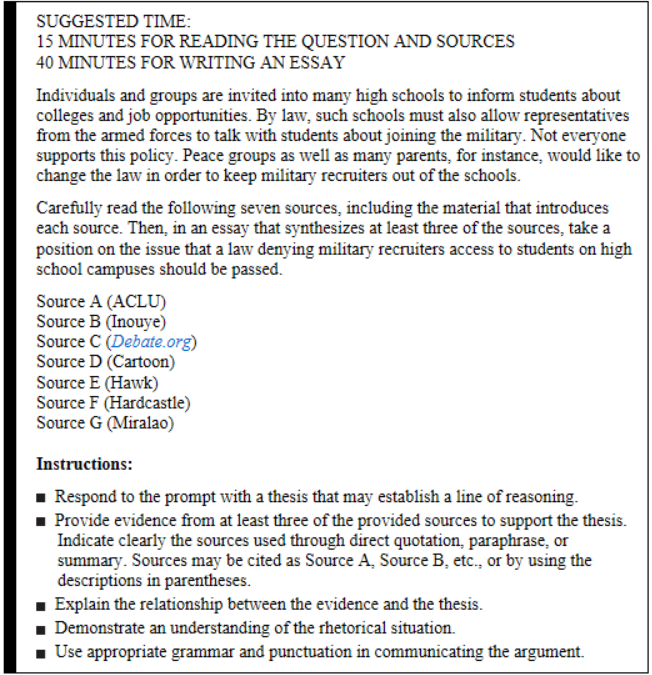
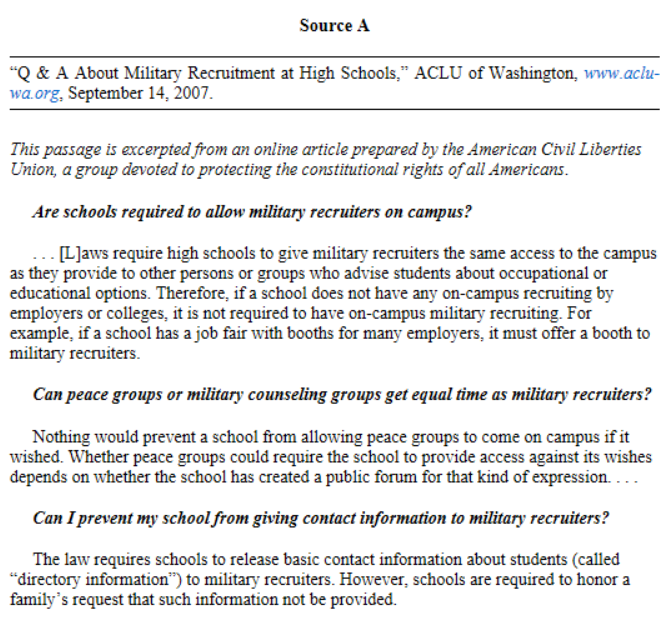
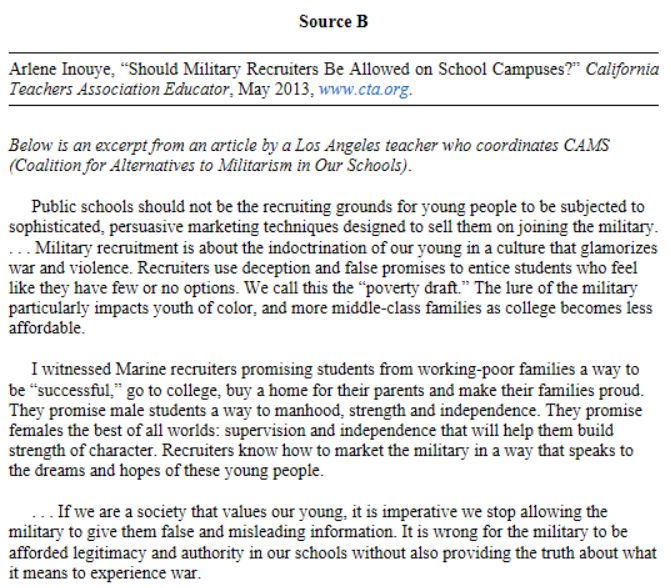
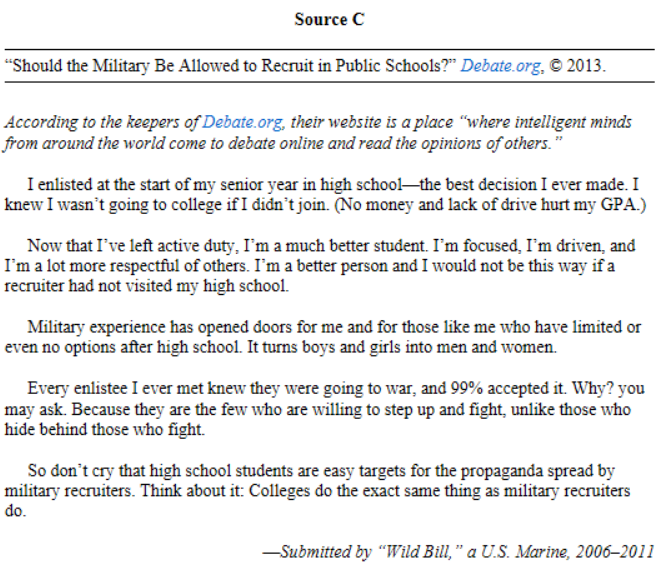


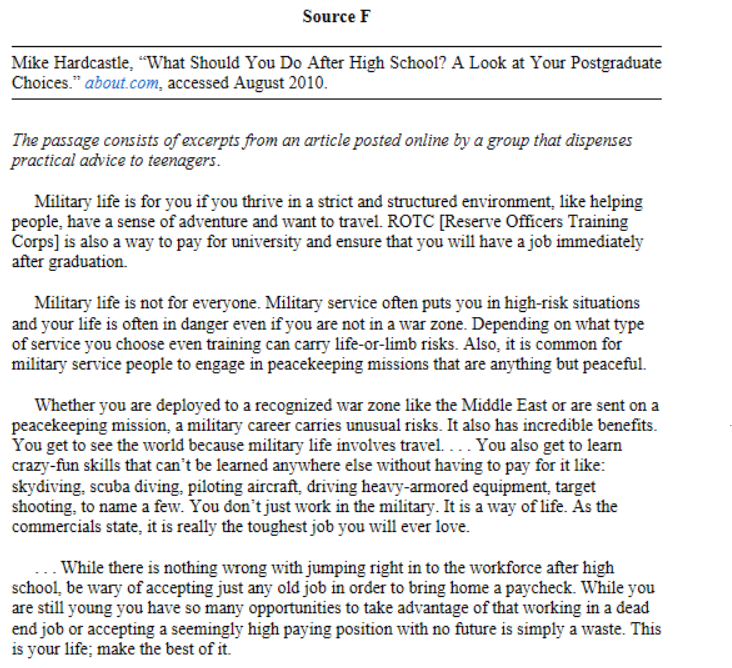
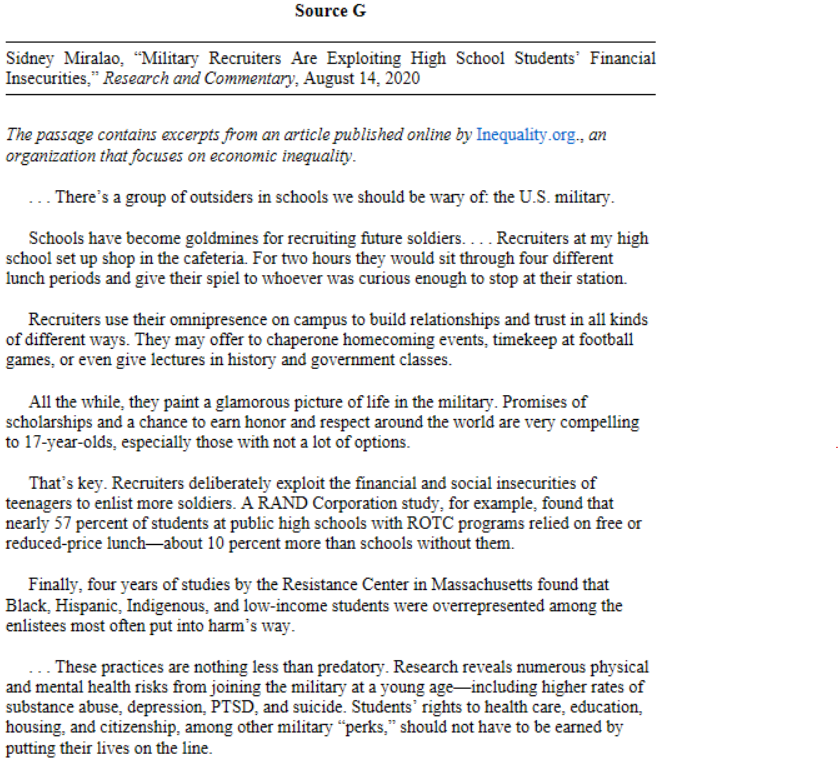
Essay Question 2
SUGGESTED TIME: 40 MINUTES
(This question counts as one-third of the total score for Section II.)
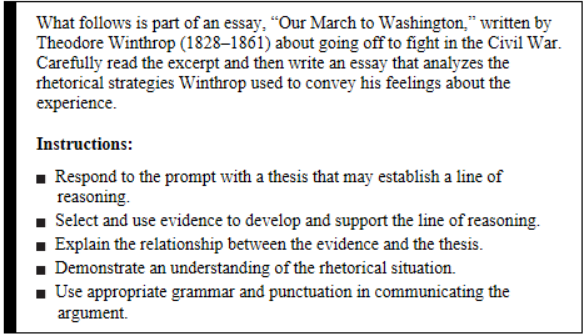
At three o’clock in the afternoon of Friday, April 19, we took our peacemaker, a neat twelve-round brass howitzer, down from the Seventh Regiment Armory, and stationed it in the rear of the building. The twin peacemaker is somewhere near us, but entirely hidden by this enormous crowd.
(5)An enormous crowd! of both sexes, of every age and condition. The men offer all kinds of truculent and patriotic hopes; the women shed tears, and say, “God bless you, boys.”
This is a part of the town where baddish cigars prevail. But good or bad, I am ordered to keep all away from the gun. So the throng stands back, peers curiously over the heads of its junior members, and seems to be taking the measure of my coffin.
(10)At a great house on the left, as we pass the Astor Library, I see a handkerchief waving for me. Yes! it is she who made the sandwiches in my knapsack. They were a trifle too thick, as I afterwards discovered, but otherwise perfection. Be these my thanks and the thanks of hungry comrades who had bites of them!
At the corner of Great Jones Street we halted for half an hour,—then, everything ready, (15)we marched down Broadway.
It was worth a life, that march. Only one who passed, as we did, through that tempest of cheers, two miles long, can know the terrible enthusiasm of the occasion. I could hardly hear the rattle of our own gun-carriages, and only once or twice the music of our band came to me muffled and quelled by the uproar. We knew now, if we had not before divined it, that our great (20)city was with us as one man, utterly united in the great cause we were marching to sustain.
This grand fact I learned by two senses. If hundreds of thousands roared it into my ears, thousands slapped it into my back. My fellow-citizens smote me on the knapsack, as I went by at the gun-rope, and encouraged me each in his own dialect. “Bully for you!” alternated with benedictions, in the proportion of two “bullies” for one blessing.
(25)I was not so fortunate as to receive more substantial tokens of sympathy. But there were parting gifts showered on the regiment, enough to establish a variety-shop. Handkerchiefs, of course, came floating down upon us from the windows like a snow. Pretty little gloves pelted us with love-taps. The sterner sex forced upon us pocket-knives new and jagged, combs, soap, slippers, boxes of matches, cigars by the dozen and the hundred, pipes to (30)smoke shag and pipes to smoke Latakia,1 fruit, eggs, and sandwiches. One fellow got a new purse with ten bright quarter-eagles.
Essay Question 3
SUGGESTED TIME: 40 MINUTES
(This question counts as one-third of the total score for Section II.)
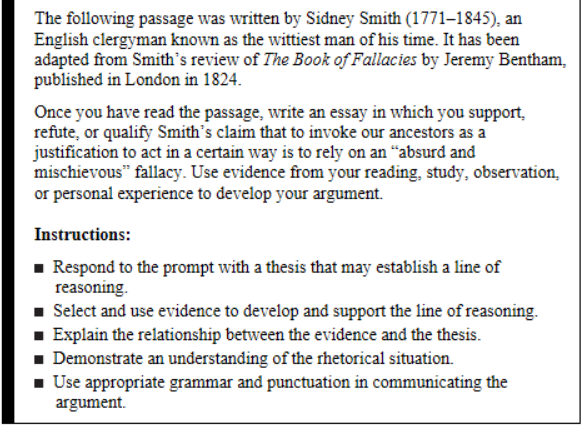
There are a vast number of absurd and mischievous fallacies, which pass readily in the world for sense and virtue, while in truth they tend only to fortify error and encourage crime. Mr. Bentham has enumerated the most conspicuous of these in the book before us . . .
(5)OUR WISE ANCESTORS—The Wisdom of Our Ancestors—The Wisdom of the Ages—Venerable Antiquity—Wisdom of Old Times—This mischievous and absurd fallacy springs from the grossest perversion of the meaning of words. Experience is certainly the mother of wisdom, and the old have, of course, greater experience than the young; but the question is who are the old? and who are the young?
(10)Of individuals living at the same period, the oldest has, of course, the greatest experience; but among generations of men the reverse is true. Those who come first (our ancestors) are the young people, and have the least experience. We have added to their experience the experience of many centuries; and, therefore, as far as experience goes, are wiser and more capable of forming an opinion than they were. The real feeling should be, not (15)can we be so presumptuous as to put our opinions in opposition to those of our ancestors? but can such young, ignorant, inexperienced persons as our ancestors necessarily were, be expected to have understood a subject as well as those who have seen so much more, lived so much longer, and enjoyed the experience of so many centuries?




